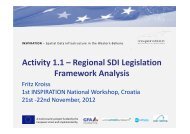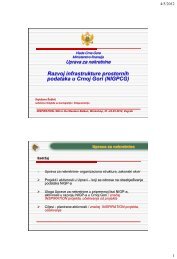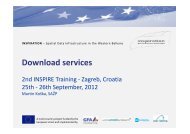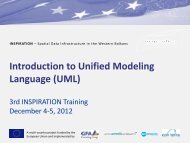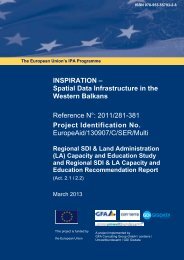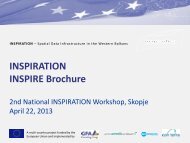MOVE - Moderation and Visualization for Group ... - INSPIRATION
MOVE - Moderation and Visualization for Group ... - INSPIRATION
MOVE - Moderation and Visualization for Group ... - INSPIRATION
You also want an ePaper? Increase the reach of your titles
YUMPU automatically turns print PDFs into web optimized ePapers that Google loves.
<strong>Group</strong> <strong>Group</strong> composition<br />
composition<br />
Altering the composition of working groups,<br />
particularly during the orientation phase, helps<br />
participants to better relate to <strong>and</strong> learn to know<br />
one other <strong>and</strong> their individual strengths <strong>and</strong><br />
weaknesses. It may also be a way to ease tension<br />
or to avoid difficult situations <strong>and</strong> boredom in<br />
group dynamics. There is a wide variety of ways<br />
how groups may be established, here are just a<br />
few:<br />
By y chance. chance. The easiest <strong>and</strong> fastest way to split<br />
the plenary into working groups is by<br />
counting up to the number of groups you<br />
wish to establish. For example, all individuals<br />
allocated the number 1 constitute group 1, all<br />
those with number 2 establish group 2 etc.<br />
You can do the same through a ‘lottery’ or by<br />
distributing puzzle pieces among participants,<br />
then asking them to find the partners<br />
matching their picture, <strong>and</strong> to <strong>for</strong>m a group.<br />
This composition mode is most useful during<br />
the early stages of an event, so that<br />
participants will relate to one another<br />
r<strong>and</strong>omly <strong>and</strong> not just communicate with the<br />
ones they already know.<br />
By y choice. choice. Let participants themselves choose in<br />
which group they want to work. Mostly, this<br />
will be based on interest in a particular issue.<br />
Make sure that the group composition is<br />
balanced in terms number <strong>and</strong> gender.<br />
By y region region or or country country. country . In international or<br />
regional workshops, it may make sense to<br />
break the participants down into regional<br />
groups. Analyzing a local situation is best<br />
achieved among people from the same area.<br />
By y professional professional background background or or institution.<br />
institution.<br />
When it comes to technical solutions or<br />
sector-specific action plans, you may want to<br />
group people who share the same professional<br />
or institutional background.<br />
By y gender gender, gender , age age or or socio-cultural<br />
socio-cultural<br />
characteristics. characteristics. It may be useful to explore<br />
the different views of women <strong>and</strong> men,<br />
young <strong>and</strong> old, hard- <strong>and</strong> soft-skilled people<br />
etc. who could find it easier to exchange in<br />
homogenous sub-groups.<br />
44<br />
By y suggestion. suggestion. When the moderation team has<br />
specific pedagogical objectives in mind, you<br />
may suggest the group composition by<br />
yourself. For example, if you want a ‘crossfertilization’<br />
of ideas, you may suggest a mix<br />
of different regions, skills, or other qualities<br />
represented in that group.<br />
Working orking in in groups<br />
groups<br />
Be<strong>for</strong>e the plenary is broken down into working<br />
groups, you should introduce the groups to the<br />
guideline “Writing on Cards,” as described under<br />
visualization competence below. The same<br />
accounts <strong>for</strong> the guideline “Collecting <strong>and</strong><br />
Structuring Ideas on Cards” presented under<br />
Phase 4 – Action <strong>and</strong> Reflection below. And, of<br />
course, you should offer some guidelines <strong>for</strong><br />
group work. It has been mentioned already that<br />
you should carefully <strong>for</strong>mulate, visualize, <strong>and</strong><br />
clarify questions or tasks <strong>for</strong> group work, <strong>and</strong><br />
that you should set time limits. Once the groups<br />
have started working, you should go around<br />
every 15-30 minutes, checking whether they are<br />
proceeding constructively.



